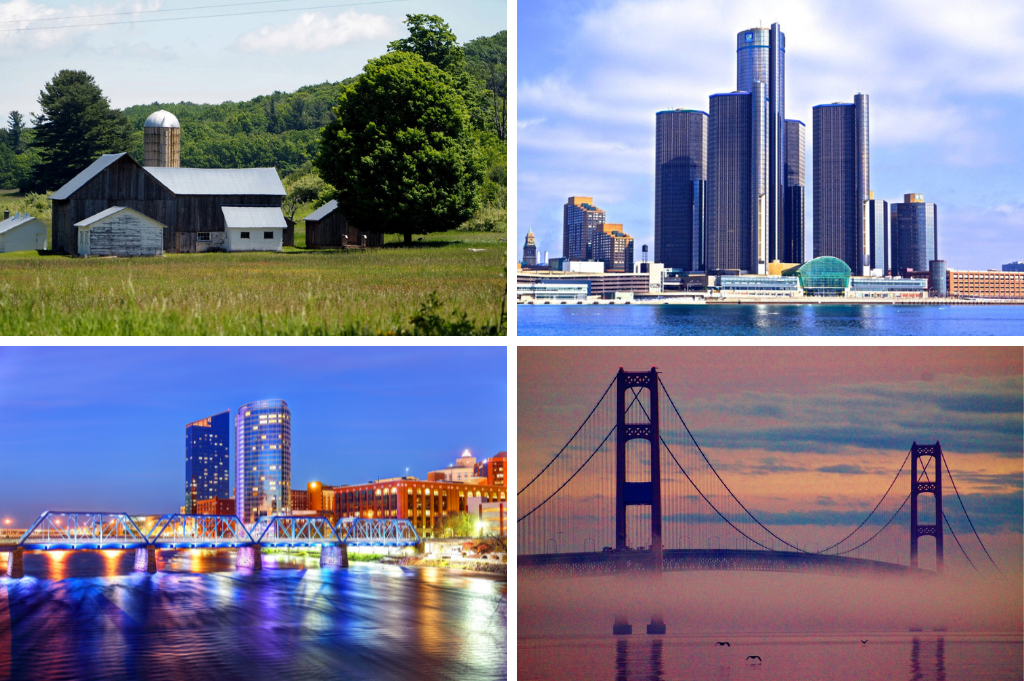(Clockwise): A Leelenau County farm, the Renaissance Center in Detroit, the Mackinac Bridge and Grand Rapids’ downtown | Susan J. Demas and Getty photos
There really is no such thing as a state economy.
Sure, we commonly compare states using statewide unemployment rates, household incomes, poverty rates, educational attainment and other socioeconomic data.
But states are a collection of regional economies that have widely varying demographics, living standards and needs. First-time visitors to Alpena and Ann Arbor would be forgiven for thinking those cities could be in different states. Grand Rapids and Flint are as economically different as, well, Grand Rapids and Flint.
Michigan’s statewide seasonally unadjusted unemployment rate in July was 5.8%. But July jobless rates in the state’s regions ranged from 4.4% in Grand Rapids to 6.8% in Monroe.
That points to why Michigan policymakers should empower regional efforts to boost prosperity across the state, a recent report by the nonpartisan Citizens Research Council of Michigan contends.
The report, prepared by CRC senior research associate Madhu Anderson, praises Gov. Gretchen Whitmer’s Growing Michigan Together Council for producing a comprehensive blueprint aimed at making Michigan a wealthier, younger state.
Growing More Prosperous Michigan
Regions graphic
The 86-page document offers numerous recommendations on how the state can achieve three major goals: establish Michigan as the Midwest’s premier innovation hub; build a lifelong learning system “focused on future-ready skills and competencies”; and create “thriving, resilient communities that are magnets for young talent.”
But the governor’s council fell short in failing to recognize the crucial role of regional efforts that will be required to lift statewide prosperity, the CRC report said.
“The Council’s high-level vision lays out an admirable set of goals, but it misses a key component in its plan for future prosperity: the diversity of regions of the state,” the report said. “Michigan is too big and diverse for a one-size-fits-all solution. It needs regional economic and demographic assessments, tailored growth strategies, and the buy-in of regional entities. Policies to grow Michigan overall will not succeed unless its regions are prosperous.”
While the state’s population has been basically flat for years at about 10 million, population trends vary regionally. A 13-county West Michigan region surrounding Grand Rapids added nearly 128,000 residents between 2010 and 2023, according to the CRC report. Conversely, a seven-county region mostly including the Thumb and Flint, lost nearly 41,000 residents in the same period.
Then-Gov. Rick Snyder recognized those differences a decade ago when his administration created the Regional Prosperity Initiative, which carved the state into 10 “prosperity regions.” The initiative was designed to customize state government services to be delivered on a regional basis, among other things.
But the CRC’s Anderson said the strategy has had uneven results, at least in the Lansing service delivery model.
“I think it’s been a mix,” she told me. “There have been some administrative hurdles in state government. It’s a messy process.”
The Michigan Economic Development Corp. (MEDC) is one agency embracing the regional development approach. Its Collaborative Development Council deploys staffers to the 10 regions’ primary economic development agencies to improve services to those regions.
“All of us understand the significance of regions, said Matt McCauley, the MEDC’s, senior vice president of regional prosperity. “When you collaborate, good things happen.”
But Tim Bartik, senior economist at the W.E. Upjohn Institute for Employment Research in Kalamazoo, said the 10 prosperity regions in many cases aren’t aligned with actual labor market conditions.
The entire Upper Peninsula is in Region One, but the Western and Eastern UP are different local labor markets, Bartik said. The same is true for Kalamazoo, a college town with a labor force more than twice as large as struggling Benton Harbor. Both are in Region Eight.
“I’m all in favor of greater regional planning, but I think you need to start with plausible planning areas,” he said.
And getting local governments to work together regionally can be a challenge. Southeast Michigan, for example, has struggled for decades to agree on building a much-needed public transit system.
But the CRC report said the 10 local regional prosperity boards “are the ideal organizations to steer the vision of growth and economic prosperity championed by the Growing Michigan Together Council.”
Data produced by the state for the prosperity regions can help inform local officials and community leaders in developing future workforces. New data show jobs that are likely to be most in demand and pay the most through 2030 in each of the 10 prosperity regions.
Growing Michigan Together Council Co-Chair John Rakolta and others have said if the state concentrates in becoming more prosperous, population growth will follow.
Anderson agrees, but says the work must be done on a region-by-region bases.
“Tailoring strategies that leverage the unique demographic, cultural, economic and infrastructure needs of the state’s regions is imperative to achieve durable success in becoming a top 10 state.”
GET THE MORNING HEADLINES DELIVERED TO YOUR INBOX

